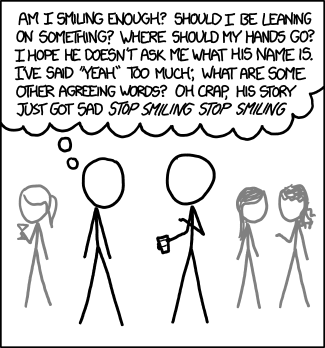
This is a continuation of last week’s post. Last week I wrote about the self-promotion skills I learned as an actor that could apply to getting a job in any field. I left out networking because when I started writing, I found I had a lot to say about it. For me, networking was the hardest part of self-promotion, but it was also the single most effective thing I did to get acting work.
I’m a serious introvert and I am also somewhat shy. I hated going to networking events until I changed the way I thought about them. I found that if I could take my focus off myself and get curious about other people, I could actually enjoy these events.
Before I get into the strategies I use, I’m going to introduce you to Keith. I met Keith in an acting class and watched him get job after job. He was a wonderful actor, but there were many other classmates who were exceptional actors who were not getting as much work. It turned out that Keith had a Rockstar superpower: networking.
When we asked how he managed to network so effectively, Keith invited a few of us from class to tag along with him at the next film meetup in town. I arrived early and sat with another classmate in the corner sipping a drink. We weren’t talking to anyone – we were barely talking to each other. Then Keith arrived and he made us stand up and follow him.
Strategy #1: Go with a friend or two. Introduce your friend(s) to everyone you know in the room. Have your friend(s) introduce you to everyone they know in the room.
Keith enthusiastically introduced us to everyone he knew. He went to these events frequently and he knew a lot of people. He was careful to make a full introduction on both sides: our names, how he knew us, and he would talk up our talents or achievements. Then we would chat and exchange business cards. These days, we might just make a quick connection on LinkedIn.
I will mention that it can be a bit dangerous to go with a friend. The inclination can be to stick together and not talk to anyone else. If you notice you are playing it safe, split up and meet back up later to introduce each other to the new people you’ve met.
Strategy #2: Make a game of it.
Keith had a deal with his wife: Martha would not pick him up from an event until he had given away at least 5 business cards.
Here are some other ideas, but you should make up your own:
- Compete with a friend to get the most LinkedIn connections
- Commit to introduce yourself to 3 people you don’t know
- Create a bingo card for yourself of things people might do or say. See if you can get a bingo.
- Make a list of unusual hobbies from people you meet
- How many people can you get to show you a picture of their kids or their pets
Try to have fun while you’re playing. If you’re having fun, people will want to talk to you.

Strategy #3: Help someone out.
For a lot of people, volunteering at an event can be a good way to ease into an unfamiliar environment. Having a task can take your focus off yourself and how uncomfortable you feel. If you are one of these people, contact the organizers ahead of the event and see if they have any opportunities to volunteer.
Even if you’re not volunteering in an official capacity, you can still help someone else. Grab another lost soul and see if they’ll help you look for a third. Or join a group of two people who look like they are bored or struggling. A group of three is less awkward than a group of two. (I would avoid joining a pair who appear to be deep in conversation because you’re likely to interrupt in a negative way.) But together, you could join a larger group that looks inviting. Just wait until there’s a lull in the conversation and introduce yourselves to the larger group.
Strategy #4: Be curious about people
Networking does not have to be a transactional activity. Most people are fascinating if you get to know them. Networking events give you a chance to meet future friends and collaborators who have common interests. You’ll probably find out where people work, but you can also find out what they love about their job, what interesting projects they’ve worked on, what they like to do when they are not working, etc.

After the event, be sure to message anyone who connected with you through LinkedIn. You can offer to connect them with someone might be able to help them or you can just let them know you enjoyed meeting them and you hope to see them at the next event.
